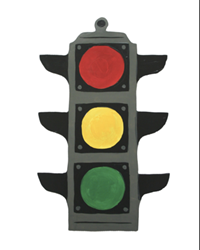News / Business
Ad Sales Training: Shweiki Media Company Presents a Webinar on How Salespeople Can Get Advertisers Out of Objection Mode and Into a More Open-Minded, Receptive Mindset
Often, before they're even approached by salespeople or have heard the pitch, advertisers have an objection-based mindset and are ready to automatically say no--in other words, they're in "red light mode." Here Shweiki Media teams up with Ryan Dohrn of Brain Swell Media and 360 Ad Sales to present a webinar on strategies to get advertisers into a more receptive, open-minded "green light mode," and eventually make the sale.

Shweiki Media Printing Company teams up with Ryan Dohrn of Brain Swell Media and 360 Ad Sales to present a webinar on how to get advertisers out of the objection-based “red light mode” and into the receptive, open-minded “green light mode.”
1. Remember Advertisers Are Typically In Red Light Mode…
Red light mode typically means that the prospect isn't listening, and the answer is ultimately going to be some version of no. For example, if one offers a client a free ad and they automatically decline, saying their budget is used up (which, of course, isn’t an issue if the ad is free), the client is clearly in red light mode and was planning on saying no from the get-go.
2. ...And Are Trained to Say No
It is very common when selling advertising for the advertiser to be engaged with the process, believe the product, and ultimately not buy. That’s because, as previously mentioned, advertisers are more often in red light mode than not, so even if they appear to be in green light mode, one needs to ask more questions. Showing signs of purchasing interest can ultimately be an objection if the advertiser just wants to fast-forward through the sales process, so one should combat this by asking questions like “Can we set up a time to review that?"
3. Don’t Give Up and Plan For Future Meetings
In today's environment, one will need to reach out to an advertising contact as many as 15-20 times to move them from red light to green light mode. Meanwhile, a brand needs to be in front of a new customer as many as 30 times before a customer will want to try out that brand. As a salesperson, one can use these stats to gain insight into the importance of earning sales trust and being persistent.
4. Ask a Bold Question...
If one has an opportunity to meet with an advertiser and encounters objections, one strategy is asking a bold question: "Why is our audience of readers not important to you?" Although it might take a bit of guts, it pressures the advertiser to come up with something more than a blatant “no.”
5. ...And Another One
Another objection-countering question that throws advertisers off guard: “Why is our audience not attractive to you?” Too often salespeople just give up, when it’s questions like these that throw the advertiser off guard and force them to think and actually evaluate one’s proposal.
6. Have an Advertising Engagement Process…
Often one will actually send out a message, get a response from an advertiser, and then never take that data the next step forward. What was one communicating? What day did one send the message? What time was the message sent? When sales start to slow, a systematic process will help salespeople get the ball rolling again. Sales preparedness is important, and one’s messaging strategy has to be sharp and needs to be tested. It’s important to find the messages that work really well and develop some type of engagement process.
7. ...And an Advertising Engagement Message
Using engaging messages and varying those messages is very important. The point of using templates isn’t just to use templates. It’s to save time and to take advantage of repeatable patterns of success. One should test their template messages and adjust them according to success rate.
8. Recognize Red Lights and Have a Response
There are no new objections in the marketplace; advertisers will simply rotate from a number of different objection phrases depending on their current business state. It's important for one to recognize that these aren't new, and to come up with a practiced, eloquent response for every one.
9. Promise Not to Waste an Advertiser’s Time
Few things are more valuable than time, and when trying to move an advertiser from red light mode into green light mode, it’s important for one to be an excellent manager of their time. It’s a good strategy to promise advertisers that their time won’t be wasted. For example: every sales call should run about 10 minutes or less. Transmitting a message quickly and effectively is the best way to get an advertiser’s respect and gain trust.
10. Create an Action Plan
There are three factors that go into putting a good habit into place: the first is knowing what to do, the next is knowing how to do it, and the third is gathering the desire to make it happen. When one has an action plan, it’s a simple matter of carrying it out. Success will follow.
Shweiki Media's mission has always been to help publishers improve by providing the most profitable, hassle-free printing experience possible. This includes guaranteeing the highest quality product, exceptional customer service, world-class communication, an on-time guarantee, and no surprises--whether printing magazines, postcards, flyers or anything else.
As a printer and publisher, Shweiki Media also believes that this hassle-free experience includes making their clients better. Utilizing relationships with industry experts, Shweiki Media strives to educate clients and help them thrive in the exciting world of publishing--while having lots of fun along the way!
For more great info from and about Shweiki Media, please check out our blog at shweiki.com/blog (and sign up for our FREE weekly expert webinars!), and subscribe to our Youtube Channel at youtube.com/shweikimedia. You can also follow us @ShweikiMedia and "like" us at Facebook.com/shweikimedia.
